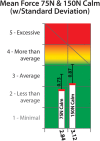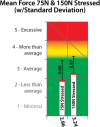Visual Estimation of Force Applied During Simulated Deliveries Complicated by Shoulder Dystocia
- PMID: 30305983
- PMCID: PMC6177338
- DOI: 10.1055/s-0038-1673377
Visual Estimation of Force Applied During Simulated Deliveries Complicated by Shoulder Dystocia
Abstract
Background Shoulder dystocia occurs when the fetal head delivers, but the shoulder is lodged behind the pubic symphysis. Training for these emergency deliveries is not optimized, and litigation can occur around a shoulder dystocia delivery. Objective Evaluate the ability of an outside observer to visually estimate the amount of traction applied to the fetal head during simulated deliveries complicated by shoulder dystocia. Study Design Simulated deliveries with an objective measurement of traction were randomly organized for estimation of traction applied. Videos show providers applying a "normal" (75 N) and "excessive" (150 N) amount of force in both a "calm" and "stressed" delivery. Results Fifty participants rated the amount of force applied. Observers estimated traction, on a scale from 1 to 5, higher in the 150-N deliveries as compared with 75-N deliveries ("calm" environment: 3.1 vs. 2.8, p < 0.001; and "stressed" environment: 3.2 vs. 2.8, p < 0.001). Only 15% of observers rated force "above average" or "excessive" in a "calm" environment, as opposed to 30% of observers in the "stressed" environment. Conclusion Observers are not able to determine when "excessive force" is used and are twice as likely to overestimate the force applied to a fetal head when an average amount of force is used and the delivery environment is stressful. Precis Observers are unable to determine when excessive traction is applied to the fetal head during simulated deliveries complicated by shoulder dystocia.
Keywords: fetal injury; legal; shoulder dystocia; simulation; traction; training.
Conflict of interest statement
Figures
Similar articles
-
Comparing McRoberts' and Rubin's maneuvers for initial management of shoulder dystocia: an objective evaluation.Am J Obstet Gynecol. 2005 Jan;192(1):153-60. doi: 10.1016/j.ajog.2004.05.055. Am J Obstet Gynecol. 2005. PMID: 15672018
-
Self-assessment and Modulation of Traction During Shoulder Dystocia Simulation Training.J Patient Saf. 2024 Sep 1;20(6):388-391. doi: 10.1097/PTS.0000000000001240. Epub 2024 Aug 6. J Patient Saf. 2024. PMID: 39101829 Free PMC article.
-
Comparing clinician-applied loads for routine, difficult, and shoulder dystocia deliveries.Am J Obstet Gynecol. 1994 Dec;171(6):1621-7. doi: 10.1016/0002-9378(94)90413-8. Am J Obstet Gynecol. 1994. PMID: 7802079
-
Shoulder dystocia: guidelines for clinical practice from the French College of Gynecologists and Obstetricians (CNGOF).Eur J Obstet Gynecol Reprod Biol. 2016 Aug;203:156-61. doi: 10.1016/j.ejogrb.2016.05.047. Epub 2016 May 30. Eur J Obstet Gynecol Reprod Biol. 2016. PMID: 27318182 Review.
-
[Shoulder dystocia: Guidelines for clinical practice--Short text].J Gynecol Obstet Biol Reprod (Paris). 2015 Dec;44(10):1303-10. doi: 10.1016/j.jgyn.2015.09.053. Epub 2015 Nov 2. J Gynecol Obstet Biol Reprod (Paris). 2015. PMID: 26541561 Review. French.
Cited by
-
Comparing forces on the fetal neck in breech delivery in lithotomy versus all-fours position: a simulation model.Arch Gynecol Obstet. 2023 Jul;308(1):91-99. doi: 10.1007/s00404-022-06671-5. Epub 2022 Jul 20. Arch Gynecol Obstet. 2023. PMID: 35857095 Free PMC article.
-
Prescriptive and proscriptive lessons for managing shoulder dystocia: a technical and videographical tutorial.Am J Obstet Gynecol. 2024 Mar;230(3S):S1014-S1026. doi: 10.1016/j.ajog.2022.03.016. Epub 2023 Aug 15. Am J Obstet Gynecol. 2024. PMID: 38462247 Free PMC article. Review.
References
-
- Grimm M J, Costello R E, Gonik B. Effect of clinician-applied maneuvers on brachial plexus stretch during a shoulder dystocia event: investigation using a computer simulation model. Am J Obstet Gynecol. 2010;203(04):3390–3.39E7. - PubMed
-
- Allen R, Sorab J, Gonik B. Risk factors for shoulder dystocia: an engineering study of clinician-applied forces. Obstet Gynecol. 1991;77(03):352–355. - PubMed
-
- Allen R H, Gurewitsch E D.Temporary Erb-Duchenne palsy without shoulder dystocia or traction to the fetal head Obstet Gynecol 2005105(5, Pt 2):1210–1212. - PubMed
-
- Deering S H, Weeks L, Benedetti T. Evaluation of force applied during deliveries complicated by shoulder dystocia using simulation. Am J Obstet Gynecol. 2011;204(03):2340–2.34E7. - PubMed
-
- Gonik B, Zhang N, Grimm M J. Prediction of brachial plexus stretching during shoulder dystocia using a computer simulation model. Am J Obstet Gynecol. 2003;189(04):1168–1172. - PubMed
Publication types
LinkOut - more resources
Full Text Sources




